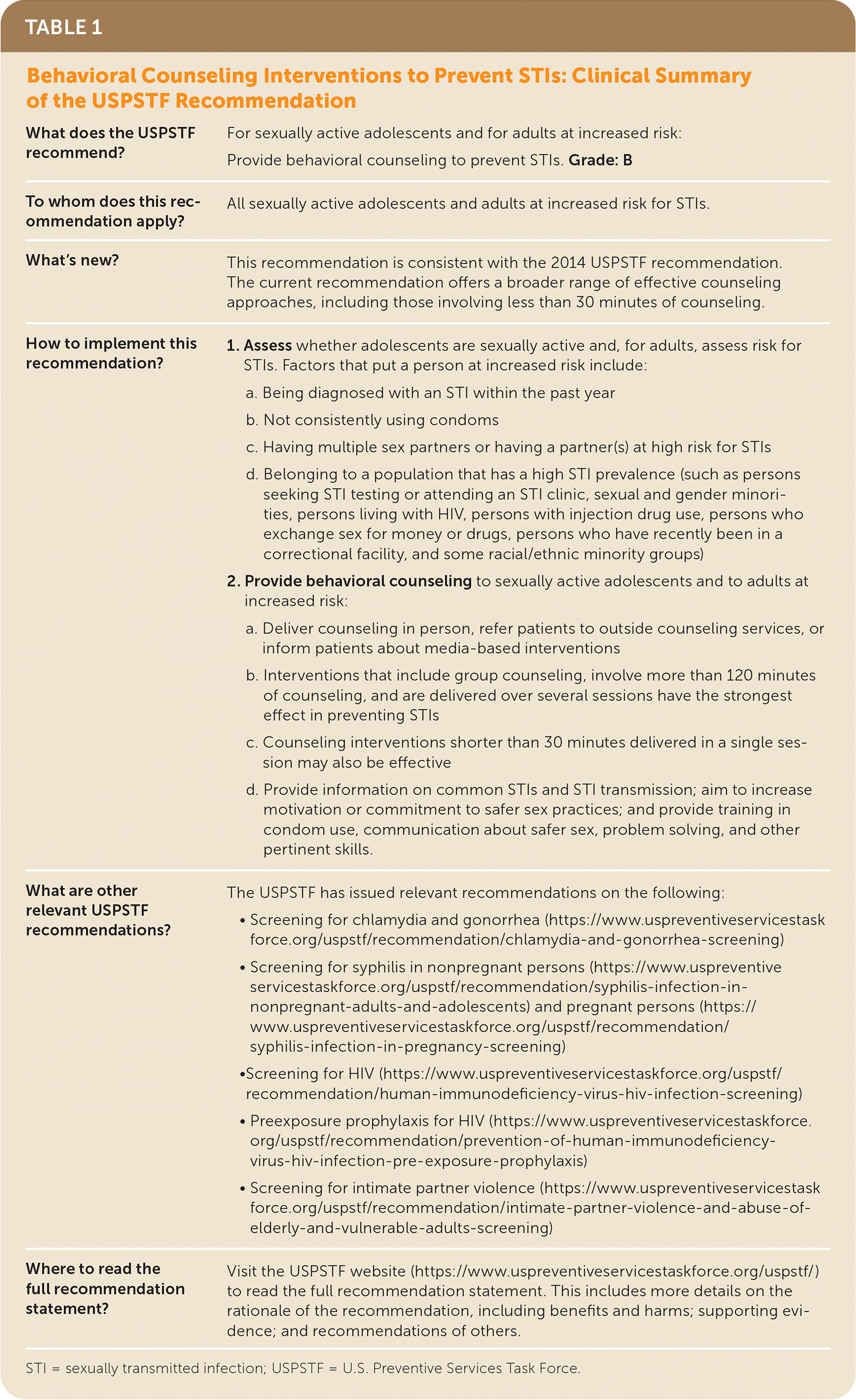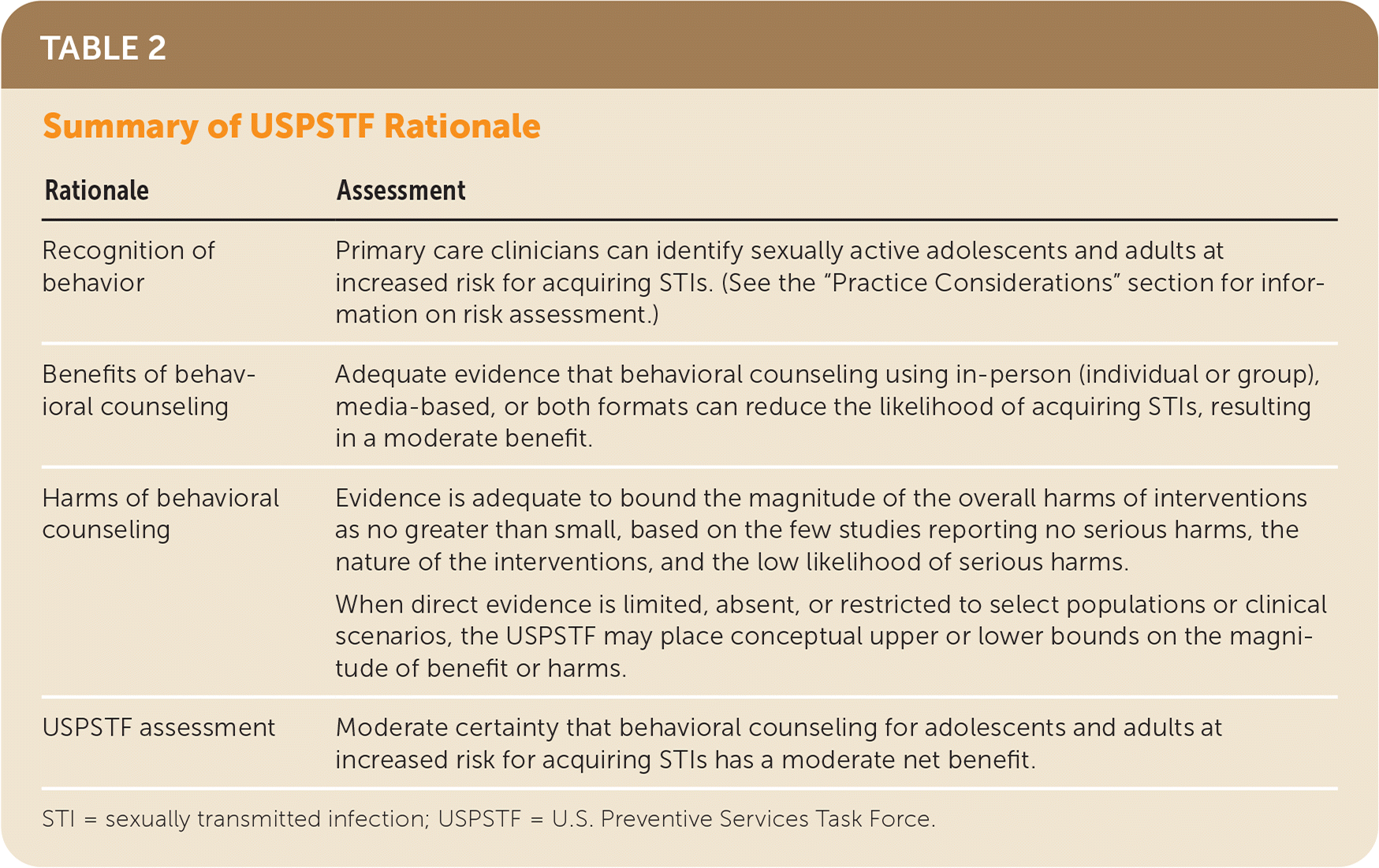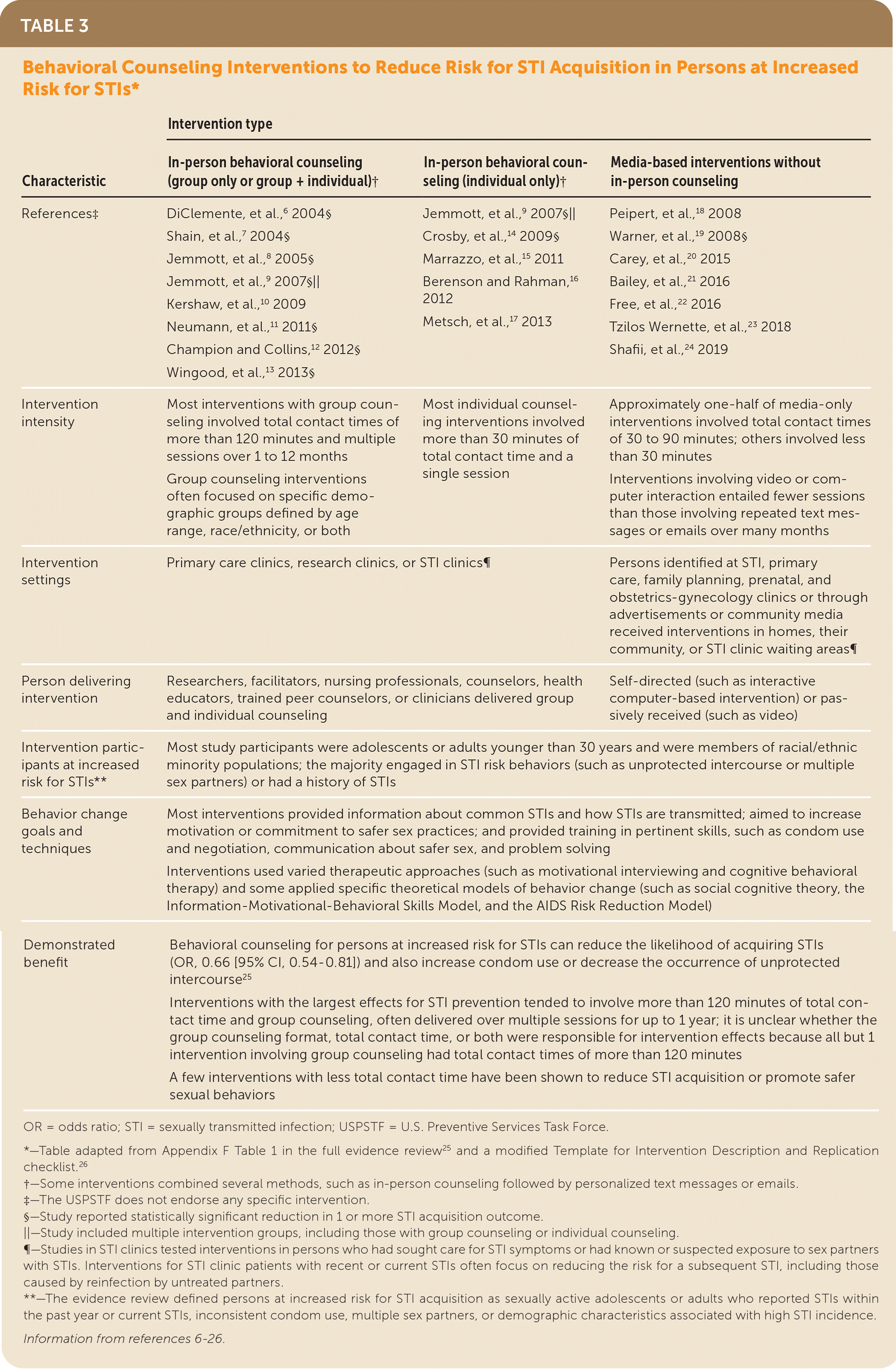
Am Fam Physician. 2020;102(9):online
Related Putting Prevention into Practice: Behavioral Counseling Interventions to Prevent Sexually Transmitted Infections
As published by the USPSTF.
Summary of Recommendation
The USPSTF recommends behavioral counseling for all sexually active adolescents and for adults who are at increased risk for sexually transmitted infections (STIs) (Table 1). B recommendation.

| What does the USPSTF recommend? | For sexually active adolescents and for adults at increased risk: Provide behavioral counseling to prevent STIs. Grade: B |
| To whom does this recommendation apply? | All sexually active adolescents and adults at increased risk for STIs. |
| What's new? | This recommendation is consistent with the 2014 USPSTF recommendation. The current recommendation offers a broader range of effective counseling approaches, including those involving less than 30 minutes of counseling. |
| How to implement this recommendation? | 1. Assess whether adolescents are sexually active and, for adults, assess risk for STIs. Factors that put a person at increased risk include:
2. Provide behavioral counseling to sexually active adolescents and to adults at increased risk:
|
| What are other relevant USPSTF recommendations? | The USPSTF has issued relevant recommendations on the following: |
| Where to read the full recommendation statement? | Visit the USPSTF website (https://www.uspreventiveservicestaskforce.org/uspstf/) to read the full recommendation statement. This includes more details on the rationale of the recommendation, including benefits and harms; supporting evidence; and recommendations of others. |
See the Practice Considerations section for more information on populations at increased risk for acquiring STIs.
Importance
Bacterial and viral STIs are common in the United States. Approximately 20 million new cases of bacterial or viral STIs occur each year in the United States, and about one-half of these cases occur in persons aged 15 to 24 years.1,2 Rates of chlamydial, gonococcal, and syphilis infection continue to increase in all regions.2 STIs are frequently asymptomatic, which may delay diagnosis and treatment and lead persons to unknowingly transmit STIs to others. Serious consequences of STIs include pelvic inflammatory disease, infertility, cancer, and AIDS. Untreated STIs that present during pregnancy or birth may cause harms to the mother and infant, including perinatal infection, serious physical and developmental disabilities, and death.3,4
USPSTF Assessment of Magnitude of Net Benefit
The USPSTF concludes with moderate certainty that behavioral counseling interventions reduce the likelihood of acquiring STIs in sexually active adolescents and in adults at increased risk, resulting in a moderate net benefit.

| Rationale | Assessment |
|---|---|
| Recognition of behavior | Primary care clinicians can identify sexually active adolescents and adults at increased risk for acquiring STIs. (See the “Practice Considerations” section for information on risk assessment.) |
| Benefits of behavioral counseling | Adequate evidence that behavioral counseling using in-person (individual or group), media-based, or both formats can reduce the likelihood of acquiring STIs, resulting in a moderate benefit. |
| Harms of behavioral counseling | Evidence is adequate to bound the magnitude of the overall harms of interventions as no greater than small, based on the few studies reporting no serious harms, the nature of the interventions, and the low likelihood of serious harms. |
| When direct evidence is limited, absent, or restricted to select populations or clinical scenarios, the USPSTF may place conceptual upper or lower bounds on the magnitude of benefit or harms. | |
| USPSTF assessment | Moderate certainty that behavioral counseling for adolescents and adults at increased risk for acquiring STIs has a moderate net benefit. |
Practice Considerations
PATIENT POPULATION UNDER CONSIDERATION
This recommendation applies to all sexually active adolescents and to adults at increased risk for STIs.
DEFINITION OF STIS
STIs are transmitted through sexual activity and intimate physical contact. In the United States, common STIs with significant clinical and public health effects include HIV, herpes simplex virus, human papillomavirus, hepatitis B virus, Chlamydia trachomatis, Neisseria gonorrhoeae, Treponema pallidum (syphilis), and Trichomonas vaginalis.1–4
ASSESSMENT OF RISK
All sexually active adolescents are at increased risk for STIs because of the high rates of STIs in this age group and should receive behavioral counseling interventions. Adults at increased risk for STIs include those who currently have an STI or were diagnosed with one within the past year, do not consistently use condoms, have multiple sex partners, or have sex partners within populations with a high prevalence of STIs. Populations with a high prevalence of STIs include persons who seek STI testing or attend STI clinics; sexual and gender minorities; persons who are living with HIV, inject drugs, have exchanged sex for money or drugs, or have entered correctional facilities; and some racial/ethnic minority groups.1–4 Difference in STI rates among racial/ethnic groups may reflect differences in social determinants of health.2 To determine which adolescents are sexually active and which adults might engage in activities that may increase their risk for STIs, clinicians should routinely ask their patients for pertinent information about their sexual history.
BEHAVIORAL COUNSELING INTERVENTIONS
Intervention approaches include in-person counseling, videos, websites, written materials, telephone support, and text messages. Most successful approaches provide information on common STIs and STI transmission; assess the person's risk for acquiring STIs; aim to increase motivation or commitment to safer sex practices; and provide training in condom use, communication about safer sex, problem solving, and other pertinent skills. Interventions that include group counseling and involve high total contact times (defined in the evidence review as more than 120 minutes), often delivered over multiple sessions, are associated with larger STI prevention effects. However, some less intensive interventions have been shown to reduce STI acquisition, increase condom use, or decrease number of sex partners. Interventions shorter than 30 minutes tended to be delivered in a single session. There is not enough evidence to determine whether several intervention characteristics were independently related to effectiveness, including degree of cultural tailoring, counselor characteristics, or setting.
IMPLEMENTATION
Primary care clinicians can deliver in-person behavioral counseling interventions, refer patients to behavioral counseling interventions in other settings, or inform patients about media-based interventions. For more information about risk assessment methods and behavioral counseling interventions, see the Additional Tools and Resources section and Table 3.6–26

| Characteristic | Intervention type | ||
|---|---|---|---|
| In-person behavioral counseling (group only or group + individual)† | In-person behavioral counseling (individual only)† | Media-based interventions without in-person counseling | |
| References‡ | DiClemente, et al.,6 2004§ Shain, et al.,7 2004§ Jemmott, et al.,8 2005§ Jemmott, et al.,9 2007§|| Kershaw, et al.,10 2009 Neumann, et al.,11 2011§ Champion and Collins,12 2012§ Wingood, et al.,13 2013§ | Jemmott, et al.,9 2007§|| Crosby, et al.,14 2009§ Marrazzo, et al.,15 2011 Berenson and Rahman,16 2012 Metsch, et al.,17 2013 | Peipert, et al.,18 2008 Warner, et al.,19 2008§ Carey, et al.,20 2015 Bailey, et al.,21 2016 Free, et al.,22 2016 Tzilos Wernette, et al.,23 2018 Shafii, et al.,24 2019 |
| Intervention intensity | Most interventions with group counseling involved total contact times of more than 120 minutes and multiple sessions over 1 to 12 months | Most individual counseling interventions involved more than 30 minutes of total contact time and a single session | Approximately one-half of media-only interventions involved total contact times of 30 to 90 minutes; others involved less than 30 minutes |
| Group counseling interventions often focused on specific demographic groups defined by age range, race/ethnicity, or both | Interventions involving video or computer interaction entailed fewer sessions than those involving repeated text messages or emails over many months | ||
| Intervention settings | Primary care clinics, research clinics, or STI clinics¶ | Persons identified at STI, primary care, family planning, prenatal, and obstetrics-gynecology clinics or through advertisements or community media received interventions in homes, their community, or STI clinic waiting areas¶ | |
| Person delivering intervention | Researchers, facilitators, nursing professionals, counselors, health educators, trained peer counselors, or clinicians delivered group and individual counseling | Self-directed (such as interactive computer-based intervention) or passively received (such as video) | |
| Intervention participants at increased risk for STIs** | Most study participants were adolescents or adults younger than 30 years and were members of racial/ethnic minority populations; the majority engaged in STI risk behaviors (such as unprotected intercourse or multiple sex partners) or had a history of STIs | ||
| Behavior change goals and techniques | Most interventions provided information about common STIs and how STIs are transmitted; aimed to increase motivation or commitment to safer sex practices; and provided training in pertinent skills, such as condom use and negotiation, communication about safer sex, and problem solving | ||
| Interventions used varied therapeutic approaches (such as motivational interviewing and cognitive behavioral therapy) and some applied specific theoretical models of behavior change (such as social cognitive theory, the Information-Motivational-Behavioral Skills Model, and the AIDS Risk Reduction Model) | |||
| Demonstrated benefit | Behavioral counseling for persons at increased risk for STIs can reduce the likelihood of acquiring STIs (OR, 0.66 [95% CI, 0.54–0.81]) and also increase condom use or decrease the occurrence of unprotected intercourse25 | ||
| Interventions with the largest effects for STI prevention tended to involve more than 120 minutes of total contact time and group counseling, often delivered over multiple sessions for up to 1 year; it is unclear whether the group counseling format, total contact time, or both were responsible for intervention effects because all but 1 intervention involving group counseling had total contact times of more than 120 minutes | |||
| A few interventions with less total contact time have been shown to reduce STI acquisition or promote safer sexual behaviors | |||
ADDITIONAL TOOLS AND RESOURCES
The following resources may help clinicians implement this recommendation.
The Centers for Disease Control and Prevention provides a tool for STI risk assessment suitable for primary care settings (https://www.cdc.gov/std/products/provider-pocket-guides.htm); provides information about behavioral counseling and other STI prevention strategies (https://www.cdc.gov/std/prevention); and maintains a compendium of evidence-based behavioral counseling interventions that have been shown to reduce STI acquisition or increase safer sexual behaviors (https://www.cdc.gov/hiv/research/interventionresearch/compendium/rr/complete.html).
The Community Preventive Services Task Force has issued recommendations on preventing HIV, other STIs, and teen pregnancy and has described effective individual- and group-level community interventions for school-aged youth (https://www.thecommunityguide.org/findings/hiv-other-stis-and-teen-pregnancy-group-based-comprehensive-risk-reduction-interventions) and for men who have sex with men (https://www.thecommunityguide.org/findings/hiv-interventions-reduce-sexual-risk-behaviors-or-increase-protective-behaviors-prevent).
The National Coalition of Sexually Transmitted Disease Directors and the National Alliance of State and Territorial AIDS Directors have developed optimal care checklists for clinicians serving male patients who have sex with men (https://www.ncsddc.org/wp-content/uploads/2017/08/provider_brochure2.pdf).
Additionally, the Centers for Disease Control and Prevention provides the following resources on how to help persons experiencing sexual violence or sex trafficking.
OTHER RELATED USPSTF RECOMMENDATIONS
The USPSTF has issued several recommendations about screening for STIs (chlamydia,27 gonorrhea,27 syphilis,28 HIV,29 hepatitis B virus,30 and human papillomavirus31) and cervical cancer 31 and offering preexposure prophylaxis to prevent HIV acquisition.32 The USPSTF has also issued a recommendation on screening for intimate partner violence and elder abuse.33
This recommendation statement was first published in JAMA. 2020;324(7):674–681.
The “Update of Previous USPSTF Recommendations,” “Supporting Evidence,” “Research Needs and Gaps,” and “Recommendations of Others” sections of this recommendation statement are available at https://www.uspreventiveservicestaskforce.org/uspstf/recommendation/sexually-transmitted-infections-behavioral-counseling#fullrecommendationstart.
The USPSTF recommendations are independent of the U.S. government. They do not represent the views of the Agency for Healthcare Research and Quality, the U.S. Department of Health and Human Services, or the U.S. Public Health Service.
